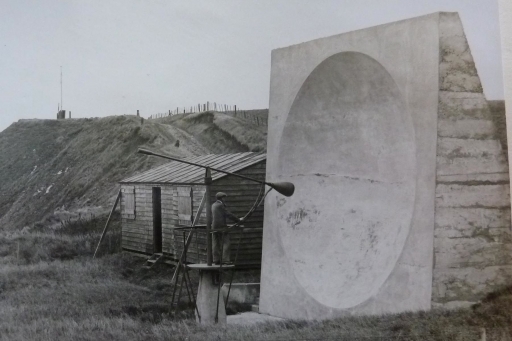Two First World War sound mirrors can now be seen at the White Cliffs of Dover by visitors to a newly-opened site on one of England’s best known stretches of coast.
The acoustic dishes, designed to give early warning of enemy aircraft, were uncovered during work by the National Trust to reopen a labyrinth of Second World War tunnels.
Fan Bay Deep Shelter was carved out of the chalk in 1940 to provide bomb-proof accommodation for soldiers manning a network of gun batteries directed against German shipping in the English Channel.
The concrete mirrors, dating from around 1917, were incorporated into the blast walls and cliff face exit. New radar technology made them obsolete in the 1930s.
A chain of sound mirrors was developed around the English coast, initially as a response to the first raids by Zeppelin airships.
The Fan Bay mirrors disappeared when the site was filled in with more than 100 tonnes of soil and rubble in the 1970s.
Excavations by National Trust archaeologists and volunteers rediscovered the 15-feet-high (4.5 metres) dishes in May 2014.
Jon Barker, visitor experience manager at the White Cliffs said: “Fan Bay Deep Shelter has a powerful effect, telling the human story behind Dover’s crucial role during the First and Second World Wars.
“The White Cliffs are forever linked to our country’s defences and the tunnels, with their graffiti-covered walls, are an emotive time capsule from this period.”
The history of sound mirrors
*Sound mirrors were one of the first early warning devices invented to give notice of approaching enemy aircraft. They were unique to the UK and a precursor to radar technology.
*The mirrors were themselves a component of a larger network of observation posts which made up the first early warning system in the world – the London Air Defence Area (LADA).
*They are also known as acoustic mirrors, listening ears, concrete ears and sound dishes, and are essentially instruments of surveillance.
*The history of sound mirrors is vague, no one can say for certain who invented them, how the concept was devised or when they were first implemented in the UK.
*It’s believed that the first experimental sound mirror dates from 1915 and was constructed near Detling Aerodrome in Kent. It was cut out of the chalk and no longer survives.
*A significant development of the time, experiments and successes with the sound mirror technique might have been crucial to the war effort and possibly informed the country’s interwar and foreign policy.
*Sound mirrors are known to have been built at 16 locations in the UK.
*The development of radar in 1935 put an end to the sound mirrors and many fell into disrepair.
*The only sound mirror outside the UK is in Malta – it was built on Commonwealth land as part of the Empire’s defence system.
How sound mirrors work
*The aim of a sound mirror was to detect enemy aircraft by the sound of their engines, and provide warning before aircraft could be seen.
*The sound mirrors at Fan Bay worked by concentrating sound waves into a central point, which were picked up by a listening apparatus facing the curved surface. An operator using a stethoscope would be stationed at the front of the mirror. Specialist training was needed to distinguish between different sounds.
*A curved sound mirror would increase the distance for hearing an aircraft’s noise. Mirrors were often made of, or lined with, concrete as this made a good sound reflective surface.
The Fan Bay Deep Shelter, opened on July 20th 2015, is accessible on a guided tour. Details are available on the National Trust website. The National Trust is a conservation charity working in England, Wales & Northern Ireland.
Centenary News has also reported on the restoration of Fulwell acoustic mirror, on the North Sea coast, by the government heritage service ‘Historic England’ in partnership with Sunderland City Council.
Information & images supplied by The National Trust
Images: © Crown Copyright/National Archives
Posted by: Peter Alhadeff, Centenary News
